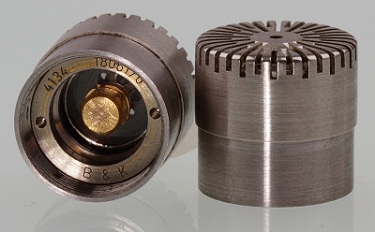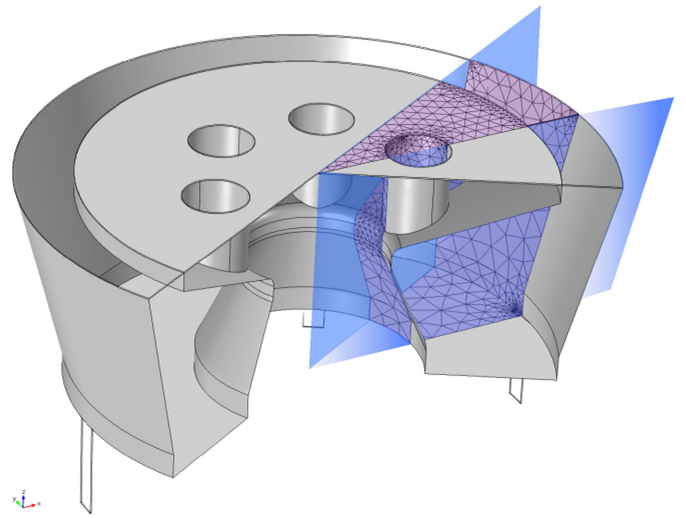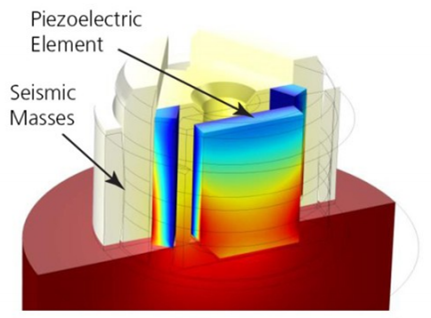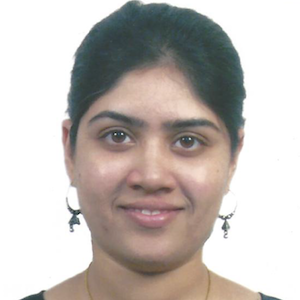
Acoustic measurements aren’t always accurate due to imperfections in the measurement tools. To limit incorrect results, devices, such as microphones and vibration transducers, have standards that define their allowable margin of error. Meeting these standards is required, but good measurement tools go a step further and keep their error range consistent over time. To create quality devices, research teams at Brüel & Kjær use multiphysics simulation to model their microphone and transducer designs.
A Leader in Measuring Sound and Vibrations: Brüel & Kjær
Brüel & Kjær, an industry leader in sound and vibration measurement for over 40 years, caters to customers like Airbus, NASA, Ferrari, and more. Their microphones range from working standard microphones to ones that are custom-made for their application. They cover a range of frequencies as well, from infrasonic to ultrasonic. For each desired application and frequency, there are multiple factors in the microphone’s design that affect its performance.

A 4134 microphone including the protective grid covering the diaphragm.
When sound enters a microphone, the sound pressure waves cause the diaphragm to vibrate, and these vibrations are then converted to sound decibels. This process means that modeling a microphone requires accounting for mechanical, electrical, and acoustic phenomena in a tightly coupled setup — something that could only be achieved with a multiphysics simulation tool. To see whether a microphone’s design is consistent and reliable, Brüel & Kjær use COMSOL Multiphysics® software to test the precision of their devices and verify new designs.
Evaluating Microphones Using Multiphysics Simulation
The Brüel & Kjær Type 4134 condenser microphone, shown below, is a popular prototype for developing condenser microphones. Simulating condenser microphones requires modeling the diaphragm’s movement, membrane deformations, resonance frequency, and viscous and thermal acoustic losses. Due to a microphone’s small dimensions and large aspect ratios, the thermal and viscous losses affect their performance considerably. All of this results in the model needing to contain a lot of detail in order to be accurate.

Geometry of the Type 4134 microphone showing the mesh used in the reduced sector geometry.
To reduce the calculation time while maintaining accuracy, the researchers took advantage of model symmetry to compute thermal stress and resonance frequency. Sound pressure can be simulated with this method as well, but only when the sound is at a normal incidence to the diaphragm. When the sound wave is at a non-normal incidence the full model has to be solved.
After verifying the simulation of the Type 4134 microphone, the researchers modeled other types with parameters that could not be observed in practice. For example, they studied how an air vent affects a microphone’s ability to measure low-frequency sounds. Simulation allowed Brüel & Kjær to test innovative designs and make changes as needed. They can even create custom devices for customers on a case-by-case basis.
Designing an Optimized Vibration Transducer
In addition to improving their microphones, engineers at Brüel & Kjær also use multiphysics simulation to optimize and test their vibration transducer designs. They aim to create one with a high built-in resistance to withstand harsh environments. To accomplish this, the engineers must create a device that doesn’t have a resonant frequency in the vibration range that it would measure. Resonating in the desired vibration range would compromise the accuracy of the measurement.

Simulation results of a suspended piezoelectric vibration transducer.
To design a device that produces a flat response, researchers tried different combinations of materials and geometry. By adding a mechanical filter, they designed a vibration transducer with an error range of no more than 10 to 12%, which is well within the acceptable limits.
Narrowing the Gap to Perfect Measurements
No device can be perfect, but simulation provides a way to get as close to perfect as possible. Engineers at Brüel & Kjær can quickly and efficiently test new designs in different scenarios, getting results that they couldn’t determine experimentally. This provides them with unique knowledge to help them create innovative designs and stay ahead of the competition.
Learn More About Simulating Microphones and Transducers in COMSOL Multiphysics
- Download models similar to those shown here:
- Want to learn how to model microphones and transducers in COMSOL Multiphysics? Check out these blog posts:
- See how other people are using COMSOL Multiphysics in COMSOL News 2015




Comments (0)